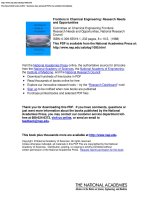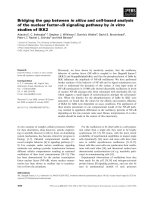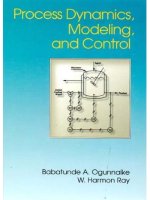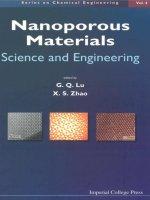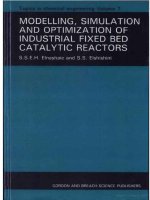mass and heat transfer analysis of mass contactors and heat exchangers (cambridge series in chemical engineering)
Bạn đang xem bản rút gọn của tài liệu. Xem và tải ngay bản đầy đủ của tài liệu tại đây (3.58 MB, 405 trang )
P1: KAE
CUFX282-pre
CUFX282/Russell
978 0 521 88670 3
March 7, 2008
This page intentionally left blank
ii
11:4
P1: KAE
CUFX282-pre
CUFX282/Russell
978 0 521 88670 3
March 7, 2008
11:4
MASS AND HEAT TRANSFER
This book allows instructors to teach a course on heat and mass transfer that will equip
students with the pragmatic, applied skills required by the modern chemical industry. This
new approach is a combined presentation of heat and mass transfer, maintaining mathematical rigor while keeping mathematical analysis to a minimum. This allows students to
develop a strong conceptual understanding and teaches them how to become proficient
in engineering analysis of mass contactors and heat exchangers and the transport theory
used as a basis for determining how the critical coefficients depend on physical properties
and fluid motions.
Students will first study the engineering analysis and design of equipment important
in experiments and for the processing of material at the commercial scale. The second
part of the book presents the fundamentals of transport phenomena relevant to these
applications. A complete teaching package includes a comprehensive instructor’s guide,
exercises, design case studies, and project assignments.
T. W. Fraser Russell is the Allan P. Colburn Professor of Chemical Engineering at the
University of Delaware. Professor Russell is a member of the National Academy of
Engineering and a Fellow of the American Institute of Chemical Engineering (AIChE).
He has been the recipient of several national honors, including the AIChE Chemical
Engineering Practice Award.
Anne Skaja Robinson is an Associate Professor of Chemical Engineering at the University of Delaware and Director of the National Science Foundation (NSF) Integrative Graduate Education and Research Traineeship program in biotechnology. She has
received several national awards, including the NSF Presidential Early Career Award for
Scientists and Engineers (PECASE/Career).
Norman J. Wagner is the Alvin B. and Julia O. Stiles Professor and Chair of the Department of Chemical Engineering at the University of Delaware. His international teaching
and research experience includes a Senior Fulbright Scholar Fellowship in Konstanz, Germany, and a sabbatical as a Guest Professor at ETH, Zurich, as well as at “La Sapienza,”
Rome, Italy.
i
P1: KAE
CUFX282-pre
CUFX282/Russell
978 0 521 88670 3
March 7, 2008
ii
11:4
P1: KAE
CUFX282-pre
CUFX282/Russell
978 0 521 88670 3
March 7, 2008
11:4
CAMBRIDGE SERIES IN CHEMICAL ENGINEERING
Series Editor:
Arvind Varma, Purdue University
Editorial Board:
Alexis T. Bell, University of California, Berkeley
Edward Cussler, University of Minnesota
Mark E. Davis, California Institute of Technology
L. Gary Leal, University of California, Santa Barbara
Massimo Morbidelli, ETH, Zurich
Athanassios Z. Panagiotopoulos, Princeton University
Stanley I. Sandler, University of Delaware
Michael L. Schuler, Cornell University
Books in the Series:
E. L. Cussler, Diffusion: Mass Transfer in Fluid Systems, Second Edition
Liang-Shih Fan and Chao Zhu, Principles of Gas–Solid Flows
Hasan Orbey and Stanley I. Sandler, Modeling Vapor–Liquid Equilibria: Cubic
Equations of State and Their Mixing Rules
T. Michael Duncan and Jeffrey A. Reimer, Chemical Engineering Design and Analysis: An Introduction
John C. Slattery, Advanced Transport Phenomena
A. Varma, M. Morbidelli, and H. Wu, Parametric Sensitivity in Chemical Systems
M. Morbidelli, A. Gavriilidis, and A. Varma, Catalyst Design: Optimal
Distribution of Catalyst in Pellets, Reactors, and Membranes
E. L. Cussler and G. D. Moggridge, Chemical Product Design
Pao C. Chau, Process Control: A First Course with MATLAB®
Richard Noble and Patricia Terry, Principles of Chemical Separations with
Environmental Applications
F. B. Petlyuk, Distillation Theory and Its Application to Optimal Design of
Separation Units
L. Gary Leal, Advanced Transport Phenomena: Fluid Mechanics and
Convective Transport
T. W. Fraser Russell, Anne Skaja Robinson, and Norman J. Wagner, Mass and Heat
Transfer
iii
P1: KAE
CUFX282-pre
CUFX282/Russell
978 0 521 88670 3
March 7, 2008
iv
11:4
P1: KAE
CUFX282-pre
CUFX282/Russell
978 0 521 88670 3
March 7, 2008
11:4
Mass and Heat Transfer
ANALYSIS OF MASS CONTACTORS
AND HEAT EXCHANGERS
T. W. FRASER RUSSELL
University of Delaware
ANNE SKAJA ROBINSON
University of Delaware
NORMAN J. WAGNER
University of Delaware
v
CAMBRIDGE UNIVERSITY PRESS
Cambridge, New York, Melbourne, Madrid, Cape Town, Singapore, São Paulo
Cambridge University Press
The Edinburgh Building, Cambridge CB2 8RU, UK
Published in the United States of America by Cambridge University Press, New York
www.cambridge.org
Information on this title: www.cambridge.org/9780521886703
© T. W. Fraser Russell, Anne Skaja Robinson, and Norman J. Wagner 2008
This publication is in copyright. Subject to statutory exception and to the provision of
relevant collective licensing agreements, no reproduction of any part may take place
without the written permission of Cambridge University Press.
First published in print format 2008
ISBN-13 978-0-511-38683-1
eBook (EBL)
ISBN-13 978-0-521-88670-3
hardback
Cambridge University Press has no responsibility for the persistence or accuracy of urls
for external or third-party internet websites referred to in this publication, and does not
guarantee that any content on such websites is, or will remain, accurate or appropriate.
P1: KAE
CUFX282-pre
CUFX282/Russell
978 0 521 88670 3
March 7, 2008
This book is dedicated to our families:
Shirley, Bruce, Brian, Carey
Clifford, Katherine, Brenna
Sabine
vii
11:4
P1: KAE
CUFX282-pre
CUFX282/Russell
978 0 521 88670 3
March 7, 2008
viii
11:4
P1: KAE
CUFX282-pre
CUFX282/Russell
978 0 521 88670 3
March 7, 2008
11:4
Contents
Preface
page xiii
To the Student
xv
Acknowledgments
xix
Instructors’ and Readers’ Guide
xxi
PART I
1
Introduction . . . . . . . . . . . . . . . . . . . . . . . . . . . . . . . . . . . . . . . . . . 3
References
2
19
Chemical Reactor Analysis . . . . . . . . . . . . . . . . . . . . . . . . . . . . . . . 20
2.1 The Batch Reactor
2.1.1 Chemical Equilibrium
2.2 Reaction Rate and Determination by Experiment
2.2.1 Rate Expression
2.2.2 Approach to Equilibrium
2.3 Tank-Type Reactors
2.3.1 Batch Reactors
2.3.2 Semibatch Reactors
2.3.3 Continuous Flow
2.4 Tubular Reactors
2.5 Reactor Energy Balance
References
Problems
3
21
25
26
26
32
33
34
34
37
42
47
51
51
Heat Exchanger Analysis . . . . . . . . . . . . . . . . . . . . . . . . . . . . . . . . 55
3.1 Batch Heat Exchangers
3.1.1 Level I Analysis
3.1.2 Level II Thermal Equilibrium
3.2 Rate of Heat Transfer and Determination by Experiment
3.2.1 Rate Expression
3.2.2 Approach to Equilibrium
56
57
58
60
61
65
ix
P1: KAE
CUFX282-pre
CUFX282/Russell
x
978 0 521 88670 3
March 7, 2008
11:4
Contents
3.3 Tank-Type Heat Exchangers
3.3.1 Batch Heat Exchanger
3.3.2 Semibatch Heat Exchanger
3.3.2.1 Mixed–Mixed Fluid Motions
3.3.2.2 Mixed–Plug Fluid Motions
3.3.3 Continuous-Flow Tank-Type Heat Exchangers
3.3.3.1 Mixed–Mixed Fluid Motions
3.3.3.2 Mixed–Plug Fluid Motions
3.4 Tubular Heat Exchangers
3.4.1 Cocurrent Flow
3.4.2 Countercurrent Flow—Double-Pipe Heat Exchanger
3.5 Technically Feasible Heat Exchanger Design
3.5.1 Design Procedure
References
Problems
Appendix. Energy Balance
4
67
68
68
69
72
74
74
78
79
81
88
94
96
102
103
109
Mass Contactor Analysis . . . . . . . . . . . . . . . . . . . . . . . . . . . . . . . . 114
4.1 Batch Mass Contactors
4.1.1 Level I Analysis
4.1.2 Level II Analysis, Phase Equilibrium
4.2 Rate of Mass Transfer and Determination by Experiment
4.2.1 Rate Expression
4.2.2 Approach to Equilibrium
4.3 Tank-Type Two-Phase Mass Contactors
4.3.1 Batch Mass Contactors
4.3.2 Semibatch Mass Contactors
4.3.2.1 Mixed–Mixed Fluid Motions
4.3.2.2 Mixed–Plug Fluid Motions
4.3.3 Continuous-Flow Two-Phase Mass Contactors
4.3.3.1 Mixed–Mixed Fluid Motions
4.3.3.2 Design of a Continuous Mixed–Mixed Mass Contactor
4.3.3.3 Mixed–Plug Fluid Motions
4.4 Tubular Two-Phase Mass Contactors
4.4.1 Cocurrent Flow
4.4.2 Countercurrent Flow
4.4.3 Gas–Liquid Countercurrent Contactors
4.5 Continuous-Flow Mass Contactor Design Summary
118
119
120
125
127
132
134
135
137
138
139
143
144
146
153
156
158
159
164
168
References
Problems
Appendix A. “Log-Mean” Concentration Difference
Appendix B. Equivalence Between Heat and Mass Transfer
175
175
178
Model Equations
180
Nomenclature for Part I . . . . . . . . . . . . . . . . . . . . . . . . . . . . . . . . . . . 181
P1: KAE
CUFX282-pre
CUFX282/Russell
978 0 521 88670 3
March 7, 2008
11:4
Contents
xi
PART II
5
Conduction and Diffusion . . . . . . . . . . . . . . . . . . . . . . . . . . . . . . . 187
5.1 Rate of Thermal Conduction
5.1.1 Experimental Determination of Thermal Conductivity k and
Verification of Fourier’s Constitutive Equation
5.1.2 Definition of the Biot Number for Heat Transfer
5.1.3 Definition of the Nusselt Number
5.2 Rate of Molecular Diffusion
5.2.1 Experimental Determination of Binary Diffusivities DAB and
Verification of Fick’s Constitutive Equation
5.2.2 Definition of the Biot Number for Mass Transfer
5.2.3 Definition of the Sherwood Number
5.3 Geometric Effects on Steady Heat Conduction and Diffusion in
Solids and Quiescent Fluids
5.3.1 One-Dimensional Heat Conduction in Nonplanar Geometries
5.3.2 One-Dimensional Diffusion in a Conical Geometry
5.4 Conduction and Diffusion Through Composite Layered Materials
in Series
5.4.1 Overall Heat Transfer Coefficient for Composite Walls:
Resistance Formulation
5.4.2 Overall Heat Transfer Coefficient for a Tubular Exchanger
5.4.3 Overall Mass Transfer Coefficient for Diffusion Through a
Composite Wall
5.5 Molecular Conduction and Diffusion with Generation
5.5.1 Radial Heat Conduction with Generation
5.5.2 Diffusion with Chemical Reaction
5.6 Diffusion-Induced Convection: The Arnold Cell
5.7 Basics of Membrane Diffusion: The Sorption–Diffusion Model
5.8 Transient Conduction and Diffusion
5.8.1 Short-Time Penetration Solution
5.8.2 Small Biot Numbers—Lumped Analysis
Nomenclature
Important Dimensionless Groups
References
Problems
6
187
187
195
199
201
201
206
208
209
209
211
212
212
217
220
222
222
224
225
230
231
233
235
236
238
239
240
Convective Heat and Mass Transfer . . . . . . . . . . . . . . . . . . . . . . . . 246
6.1 The Differential Transport Equations for Fluids with Constant
Physical Properties in a Laminar Boundary Layer
6.1.1 Mass Conservation—Continuity Equation
6.1.2 Momentum Transport—Navier–Stokes Equation
6.1.3 Energy Conservation
6.1.4 Species Mass Conservation
6.2 Boundary-Layer Analysis and Transport Analogies
247
248
249
250
252
254
P1: KAE
CUFX282-pre
CUFX282/Russell
xii
978 0 521 88670 3
March 7, 2008
11:4
Contents
6.2.1 Laminar Boundary Layer
6.2.2 Reynolds Transport Analogy
6.2.3 Effects of Material Properties: The Chilton–Colburn Analogy
6.2.4 Turbulent Boundary Layers
6.3 Transport Correlations for Specific Geometries
6.4 Models for Estimating Transport Coefficients in Fluid–Fluid Systems
6.4.1 Film Theory
6.4.2 Penetration Theory
6.4.3 Surface Renewal Theory
6.4.4 Interphase Mass Transfer
6.5 Summary of Convective Transport Coefficient Estimations
6.5.1 Heat Exchangers
6.5.2 Mass Contactors
Nomenclature
References
Problems
Appendix A. Derivation of the Transport Equations
Appendix B. Vector Notation
7
254
257
260
263
264
273
273
273
278
279
281
281
284
286
287
287
293
299
Estimation of the Mass Transfer Coefficient and Interfacial
Area in Fluid–Fluid Mass Contactors . . . . . . . . . . . . . . . . . . . . . . . . 301
7.1 Estimation of Bubble and Drop Size
7.2 Tank-Type Mass Contactors
7.2.1 Mixed–Mixed Interfacial Area Estimation
7.2.2 Mixed–Mixed Km Estimation
7.2.3 Mixed–Plug Area Estimation
7.2.4 Mixed–Plug Km Estimation
7.3 Tubular Contactors
7.3.1 Cocurrent Area Estimation
7.3.2 Cocurrent Km Estimation
7.3.3 Countercurrent Area Estimation
7.3.4 Countercurrent Km Estimation
Nomenclature
References
Problems
Appendix. Bubble and Drop Breakage
8
304
307
307
309
309
313
316
316
318
318
320
320
321
322
323
Technically Feasible Design Case Studies . . . . . . . . . . . . . . . . . . . . 327
8.1 Technically Feasible Design of a Heat Exchanger
8.2 Technically Feasible Design of a Countercurrent Mass Contactor
8.3 Analysis of a Pilot-Scale Bioreactor
328
335
345
Nomenclature
References
Problems
353
354
354
Index
363
P1: KAE
CUFX282-pre
CUFX282/Russell
978 0 521 88670 3
March 7, 2008
11:4
Preface
Chemical engineers educated in the undergraduate programs of departments of
chemical engineering have received an education that has been proven highly effective. Chemical engineering educational programs have accomplished this by managing to teach a methodology for solving a wide range of problems. They first did so
by using case studies from the chemical process industries. They began case studies
in the early part of the 20th century by considering the complete processes for the
manufacture of certain chemicals and how they were designed, operated, and controlled. This approach was made much more effective when it was recognized that
all chemical processes contained elements that had the same characteristics, and the
education was then organized around various unit operations. Great progress was
made during the 1940s and 1950s in experimental studies that quantified the analysis
and design of heat exchangers and equilibrium stage operations such as distillation.
The 1960s saw the introduction of reaction and reactor analysis into the curriculum,
which emphasized the critical relationship between experiment and mathematical
modeling and use of the verified models for practical design. We have built upon this
approach, coupled with the tools of transport phenomena, to develop this text.
Our approach to teaching mass and heat transfer has the following goals:
1. Teach students a methodology for rational, engineering analysis of problems in
mass and heat transport, i.e., to develop model equations to describe mass and
heat transfer based on the relationship between experimental data and model.
2. Using these model equations, teach students to design and interpret laboratory
experiments in mass and heat transfer and then to effectively translate this knowledge to the operation and design of mass and heat transfer equipment.
3. Develop the students’ molecular understanding of the mechanisms of mass and
heat transfer in fluids and solids and application in the estimation and correlation
of mass and heat transfer coefficients.
To achieve these goals we use the following methods:
r Emphasize the critical role of experiment coupled with the development of an
appropriate model.
r Focus attention on analysis and model development rather than on mathematical manipulation of equations. This is facilitated by organization of the analysis
method into levels.
xiii
P1: KAE
CUFX282-pre
CUFX282/Russell
xiv
978 0 521 88670 3
March 7, 2008
11:4
Preface
r Provide a rational framework for analyzing mass and heat transfer phenomena
in fluids and the associated equipment based on a simple fluid mechanical model
of the devices.
r Treat mass transfer on an equal level with heat transfer, and, wherever possible,
provide a parallel development of mass and heat transfer phenomena.
The levels of analysis introduced in Chapter 1, Table 1.1, provide a guide to
the rational analysis of engineering transport equipment and transport phenomena
in increasing orders of complexity. The information obtainable from each level of
analysis is delineated and the order of analysis preserved throughout the textbook.
We present the material in a manner also suitable for nonmajors. Students with
a basic college-level understanding of thermodynamics, calculus, and reaction kinetics should be prepared to follow the presentation. By avoiding the more tedious
and sophisticated analytical solution methods and relying more on simplified model
equations and, where necessary, modern mathematical software packages, we strive
to present the philosophy and methodology of engineering analysis of mass and heat
transfer suitable for nonmajors as well. Note that a course in fluid mechanics is not
a prerequisite for understanding most of the material presented in this book.
Engineering starts with careful analysis of experiment, which naturally inspires
the inquiring mind to synthesis and design. Early emphasis on developing model
equations and studying their behavior enables the instructor to involve students in
problem-based learning exercises and transport-based design projects right from the
beginning of the course. This and the ability to challenge students to apply their
analysis skills and course knowledge to transport phenomena in the world around
them, especially in emerging technologies in the nanosciences and environmental and
biological sciences, result, in our experience, in an exciting and motivating classroom
environment. We sincerely hope that you as reader will find this approach to transport
phenomena to be as fresh and invigorating as we have.
Get the habit of analysis—analysis will in time enable synthesis to become your
habit of mind.
— Frank Lloyd Wright
P1: KAE
CUFX282-pre
CUFX282/Russell
978 0 521 88670 3
March 7, 2008
11:4
To the Student
This text is designed to teach you how to carry out quantitative analysis of physical
phenomena important to chemical professionals. In the chemical engineering curriculum, this course is typically taught in the junior year. Students with adequate
preparation in thermodynamics and reactor design should be successful at learning
the material in this book. Students lacking a reactor design course, such as chemists
and other professionals, will need to pay additional attention to the material in
Chapter 2 and may need to carry out additional preparation by using the references
contained in that chapter. This book uses the logic employed in the simple analysis
of reacting systems for reactor design to develop the more complex analysis of mass
and heat transfer systems.
Analysis is the process of developing a mathematical description (model) of a
physical situation of interest, determining behavior of the model, comparing the
behavior with data from experiment or other sources, and using the verified model
for various practical purposes.
There are two parts in the analysis process that deserve special attention:
r developing the mathematical model, and
r comparing model behavior with data.
Our experience with teaching analysis for many years has shown that the model
development step can be effectively taught by following well-developed logic. Just
what constitutes agreement between model behavior and data is a much more complex matter and is part of the art of analysis. This is more difficult to learn and requires
one to consider many different issues; it always depends on the reasons for doing the
analysis. Time constraints have a significant impact on this decision, as do resources
available. We will illustrate this aspect of analysis by examining chemical reactors,
heat exchangers, and mass contactors, equipment of particular interest to chemical
professionals.
Determining model behavior requires you to remember some calculus—how to
solve algebraic equations and some simple differential equations. This step in analysis is often given too much emphasis because it is the easiest part of analysis to
do and is the step for which students have the best background. Do not fall into
the common trap of assuming that analysis is primarily concerned with determining model behavior—it is not! Analytical methods to solve algebraic or differential
equations are most useful if the manipulations leading to solution give insights into
xv
P1: KAE
CUFX282-pre
CUFX282/Russell
xvi
978 0 521 88670 3
March 7, 2008
11:4
To the Student
the physical situation being examined. Tedious algebraic manipulations are not helpful and seriously distract one from the real purpose of analysis. You should stop and
ask questions of any instructor who performs a lot of algebra at the board without
constantly referring back to what the manipulations mean in terms of the physical
situation being studied. In this day and age, computer programs that solve sets of
equations are so readily available that tedious algebra is not required.
Once you have mastered how to obtain the model equations, you need to devote
your creative energies to deciding if behavior matches experiment. Just what constitutes a match is not trivial to determine.
The model development step is simplified by considering the level of complexity
required to obtain useful practical results. We define six levels of complexity in this
text:
The first level employs only the laws of conservation of mass and/or energy.
Time is the only dependent variable in the differential equations considered
in Level I analysis, but many problems of considerable significance assume
steady state and eliminate time as a variable. In this case the model equations
become algebraic.
The second level also employs these two conservation laws, but, in addition,
phase, thermal, or chemical equilibrium is assumed. The model equations in
a Level II analysis are algebraic because time is not an independent variable
when equilibrium is assumed.
A Level III analysis requires a constitutive relationship to be employed. The six
constitutive relations needed in studying reactors, heat exchangers, and mass
contactors are shown in Tables 1.4 and 1.5. These relations have been verified
by various experiments that we will discuss in some detail. Level III analysis assumes simple fluid motions, either well mixed or plug flow. Completely
stagnant fluids or solid phases can also be handled at this level of analysis.
A background in fluid mechanics is not required. A Level III analysis allows
one to complete equipment design at the laboratory, pilot, and commercial
scales for most single-phase systems. The Level III model equations for wellmixed fluids contain time as the only independent variable if steady state is
not assumed. Plug-flow fluid motions require one independent spatial variable
in the steady state and time if the steady state cannot be assumed.
To deal effectively with multiphase systems, a Level IV analysis needs to be performed. The Level IV analysis also assumes simple fluid motions but requires
application of the conservation laws of mass and energy coupled with constitutive relations for both phases.
A Level V analysis is restricted to single-phase systems but can employ all the
conservation laws. It is the first level in which the law of conservation of
momentum is used. In its most complicated form, the model equations of
Level V can have time and all three spatial coordinates as independent variables. A Level V analysis considering time and only one spatial direction will
be sufficient for most problems we will analyze in this book.
Multiphase systems with complex fluid motion require a Level VI analysis, which
we will not consider in this text.
P1: KAE
CUFX282-pre
CUFX282/Russell
To the Student
978 0 521 88670 3
March 7, 2008
11:4
xvii
There are two parts to this book. An introduction to the material and method
of approach is followed by chapters on chemical reactor analysis (Chapter 2), heat
exchanger analysis (Chapter 3), and mass contactor analysis (Chapter 4). These chapters have been developed to highlight the similarities in the analysis methods and in
the process equipment used. By using experimentally determined values of the rate
constant (k), the heat transfer coefficient (U), the mass transfer coefficient (Km ), and
the interfacial area (a), you will be able to solve problems in mass and heat transfer
and develop operating and design criteria.
Part II features additional chapters that focus on the microscopic analysis of
control volumes to estimate U or Km for a broad range of systems. Correlations for
Km and U are developed that facilitate the design of equipment.
Chapter 7 provides methods for calculating the area for mass transfer in a variety
of mass contacting equipment. Chapter 8 illustrates the technically feasible design
procedure through case studies of common mass contactors and heat exchangers.
On successful completion of a course using this textbook, you should understand
the basic physical principles underlying mass and heat transfer and be able to apply
those principles to analyze existing equipment and design and analyze laboratory
experiments to obtain data and parameters.
Finally, you should be capable of performing technically feasible designs of mass
contactors and heat exchangers, as well as reading the technical literature so as to
continue your education and professional development in this field.
P1: KAE
CUFX282-pre
CUFX282/Russell
978 0 521 88670 3
xviii
March 7, 2008
11:4
P1: KAE
CUFX282-pre
CUFX282/Russell
978 0 521 88670 3
March 7, 2008
11:4
Acknowledgments
The preparation of this text has benefited from significant contributions from numerous Teaching Fellows, teaching assistants, undergraduate students, and colleagues in
the Department of Chemical Engineering at the University of Delaware. In particular, we wish to acknowledge the Teaching Fellow program in the Chemical Engineering Department at Delaware, which provides a fellowship semester to a senior
graduate student who wishes an internship in university education methods and theory. This competitive program has been in existence since 1992 and has supported 24
student Teaching Fellows (1992–2007). To date, more than 10 former Fellows have
become faculty members at a number of institutions.
The Teaching Fellows work closely with faculty in lesson planning, classroom
delivery, and discussion of classroom performance. All in-class teaching by Fellows
is monitored by the faculty mentors. Regular lively discussions over course content
and teaching methods have proven to be infectious, such that many more graduate
students and faculty also benefit from active discussions about educational methods
and theory. This in fact may well be one of the most important aspects of our program.
This textbook represents a course organization that is fundamentally different
from all other courses and textbooks on mass and heat transfer. Our approach builds
upon the principles of analysis developed in the text by Russell and Denn, Introduction to Chemical Engineering Analysis. The authors, our Teaching Fellows, and
teaching assistants evolved the present text through much spirited debate. Our first
Teaching Fellow to work on the material in this text was Will Medlin, who taught
with Anne Skaja Robinson and T. W. Fraser Russell. Will’s enthusiastic acceptance of
a different approach to teaching mass and heat transfer and his lively debates with
other graduate students helped simplify and categorize the types of fluid motions
required for modeling mass and heat transfer equipment and the level analysis that
is the hallmark of the modeling approach used here. Jonathan Romero, our next
Teaching Fellow, helped organize the transfer coefficient correlations. Will’s office
mate was Suljo Linic, an undergraduate physics major who came to Delaware to do
graduate work in chemical engineering. This serendipity produced some very lively
debates, which often migrated to a faculty office. Typical of such discussions was the
following:
“Why can’t we solve all problems in mass and heat transfer with Fourier’s or Fick’s
law and the appropriate set of differential equations?”
xix
P1: KAE
CUFX282-pre
CUFX282/Russell
xx
978 0 521 88670 3
March 7, 2008
11:4
Acknowledgments
Answered by:
“In the first place, they are not laws but constitutive equations, which themselves
have only been verified for solid control volumes or liquid control volumes with no
fluid motion . . .”
Suljo was awarded the Teaching Fellow position the next year, with Norman J.
Wagner and T. W. Fraser Russell coteaching the course. His willingness to question
the fundamental principles of our analysis disciplined all of us in systematically using
level analysis to approach problems in heat transfer. Wim Thielemans, the fourth
Fellow, helped redraft the chapter on heat transfer based on undergraduate student
comments and solved a number of models numerically to illustrate model behavior.
Mark Snyder accepted the Teaching Fellow position in our fifth year and made significant contributions by classifying mass transfer unit operations equipment using our
simplified fluid mechanics analysis. Yakov Lapitsky, Jennifer O’Donnell, and Michelle
O’Malley, our sixth, seventh, and eighth Teaching Fellows contributed to numerous
examples and tested material in class.
We have also been blessed by an enthusiastic cadre of Delaware undergraduates,
who have both challenged us to become better educators and, in some special cases,
have made significant contributions to the course content through original research
projects. In particular, we would like to thank Patrick Schilling, who contributed to
the organization and numerical examples found in Chapter 3. Patrick’s interest in
the topic expanded over the following summer, when he performed original research
under our direction on predicting interfacial areas in fluid–fluid systems for use in
mass transfer operations, which are summarized in Chapter 7. Our undergraduate
classes in the junior-level course in heat and mass transfer have helped clarify and
correct errors in the manuscript that we used in class. Other undergraduates and
alumni made significant contributions: Matt Mische (heat exchanger design), Steven
Scully (manuscript review), Brian J. Russell (index), and Josh Selekman (graphs).
Any remaining errors are the authors’ responsibility.
We also wish to thank the numerous graduate students who contributed to this
manuscript and the course through dedicated service as teaching assistants. Brian
Lefebvre, Kevin Hermanson, Nicole Richardson, Yakov Lapitsky, Amit Kumar, Matt
Helgeson, and Rebecca Brummitt all made significant contributions to the materials
found herein. Brian, Kevin, and Yakov were inspired to become the Teaching Fellows
in various courses after their positive experience in the mass and heat transfer course.
Damien Th´ v´ nin took great care in preparing some of the figures in this text, and
e e
Claudio Gelmi helped analyze the fermentor data.
Multiple authors lead to lively and spirited debates, which results in chaos concerning a written manuscript. The authors are indebted to the organizational and
secretarial skills of Lorraine Holton, who typed the final manuscript, and Carrie
Qualls, who prepared the figures to Cambridge University Press standards.
Fraser Russell would like to recognize the influence on this text of his years at
Delaware when he collaborated closely with M. M. Denn, who taught him how to
effectively interpret mathematical models.
We also benefited from the support and encouragement of the Department of Chemical Engineering, our colleagues, and our families, to whom we are most grateful.
We greatly appreciated the effective efforts of Michelle Carey, Cambridge University Press, and Katie Greczylo, Aptara, Inc., in the production of this book.
P1: KAE
CUFX282-pre
CUFX282/Russell
978 0 521 88670 3
March 7, 2008
11:4
Instructors’ and Readers’ Guide
This book is designed to teach students how to become proficient in engineering
analysis by studying mass and heat transfer, transport phenomena critical to chemical
engineers and other chemical professionals. It is organized differently than traditional
courses in mass and heat transfer in that more emphasis is placed on mass transfer
and the importance of systematic analysis. The course in mass and heat transfer in
the chemical engineering curriculum is typically taught in the junior year and is a
prerequisite for the design course in the senior year and, in some curricula, also
a prerequisite for a course in equilibrium stage design. An examination of most
mass and heat transfer courses shows that the majority of the time is devoted to
heat transfer and, in particular, conductive heat transfer in solids. This often leads
to overemphasis of mathematical manipulation and solution of ordinary and partial
differential equations at the expense of engineering analysis, which should stress the
development of the model equations and study of model behavior. It has been the
experience of the authors that the “traditional” approach to teaching undergraduate
transport phenomena frequently neglects the more difficult problem of mass transfer,
despite its being an area that is critical to chemical professionals.
At the University of Delaware, chemical engineering students take this course in
mass and heat transfer the spring semester of their junior year, after having courses
in thermodynamics, kinetics and reactor design, and fluid mechanics. The students’
analytical skills developed through analysis of problems in kinetics and reactor design
provide a basis for building an engineering methodology for the analysis of problems in mass and heat transfer. This text is presented in two parts, as illustrated in
Figure I. Part I of this text, shown on the figure as “Equipment-Scale Fluid Motion,”
consists of Chapters 1–4. Part II of the text is represented by the other two elements
in the figure, titled “Transport Phenomena Fluid Motion” (Chapters 5 and 6) and
“Microscale Fluid Motion” (Chapter 7). Chapter 8 draws on Parts I and II to illustrate
the design of mass contactors and heat exchangers.
Part I of this text is devoted to the analysis of reactors, heat exchangers, and
mass contactors in which the fluid motion can be characterized as well mixed or plug
flow. Table I indicates how Chapters 2, 3, and 4 are structured and details the fluid
motions in each of these pieces of equipment. Such fluid motions are a very good
approximation of what is achieved pragmatically and in those situations in which
the fluid motion is more complex. The Table I analysis provides useful limits on performance. The model equations developed in Part I are essential for the analysis of
xxi
P1: KAE
CUFX282-pre
CUFX282/Russell
xxii
978 0 521 88670 3
March 7, 2008
11:4
Instructors’ and Readers’ Guide
PART I I
PART I
EQUIPMENTSCALE
FLUID MOTION
TRANSPORT
PHENOMENA
FLUID MOTION
TANK-TYPE
Mixed–Mixed
Mixed–Plug
HEAT AND MASS
TRANSFER
COEFFICIENTS
TUBULAR
Plug–Plug
Chapters 5, 6
MICROSCALE
FLUID MOTION
CREATION OF
BUBBLES, DROPS
MOVEMENT OF
BUBBLES, DROPS,
PARTICLES
ESTIMATION OF
AREA
FOR TRANSFER
Chapters 2, 3, 4
Chapter 7
ANALYSIS OF EXISTING HEAT EXCHANGERS AND MASS CONTACTORS
Chapters 3, 4
Figure I. Analysis of existing heat exchangers and mass contactors.
existing equipment and for the design of new equipment. Experiments performed in
existing equipment, particularly at the laboratory scale, determine reaction-rate constants, heat transfer coefficients, mass transfer coefficients, and interfacial area and
are necessary to complete the correlations developed in Part II. Carefully planned
experiments are also critical to improving operation or control of existing laboratory-,
pilot-, or commercial-scale equipment.
Another way to characterize our approach to organizing the analysis of equipment
and transport problems is shown in Table II (see p. xxiv). This is presented to give
guidance to the emphasis instructors might like to place on the way they teach from
Table I. Equipment fluid motion classification
Reactors: Single phase
Reactors: Two phase
Heat exchangers
Mass contactors
Single control volume
Two control volumes
Two control volumes
Two control volumes
Tank type
Mixed–mixed
r Batch
r Semibatch
r Continuous
Tank type
Mixed–mixed
r Batch
r Semibatch
r Continuous
Tank type
Mixed–mixed
r Batch
r Semibatch
r Continuous
Tank type
Mixed–mixed
r Batch
r Semibatch
r Continuous
Mixed–plug
r Semibatch
r Continuous
Mixed–plug
r Semibatch
r Continuous
Mixed–plug
r Semibatch
r Continuous
Tubular
Plug flow
Tubular
Plug flow
r Cocurrent
Tubular
Plug–plug flow
r Cocurrent
r Countercurrent
Tubular
Plug–plug flow
r Cocurrent
r Countercurrent
P1: KAE
CUFX282-pre
CUFX282/Russell
978 0 521 88670 3
March 7, 2008
11:4
Instructors’ and Readers’ Guide
xxiii
this text. Level I and Level II analyses are discussed in the first sections of Chapters 2,
3 and 4. Chapters 2 and 3 require a Level III analysis. Chapter 4 demonstrates the
importance of a Level IV analysis. Part II continues with Level I, II, and III analyses
in Chapter 5 but introduces two new constitutive equations, shown in Table 1.4.
Chapter 6 requires a Level V analysis to develop relationships for mass and heat
transfer coefficients. This text does not deal with any Level VI issues except in a minor
way in Chapter 7, which provides methods for estimating interfacial areas in mass
contactors. In teaching the material in this text it is crucial that students understand
the critical role of experiment in verifying the constitutive equations for rate of
reaction, rate of heat transfer, and rate of mass transfer summarized in Table 1.5.
It is these constitutive equations that are used in Chapters 2, 3, and 4 in the model
equations for the fluid motions, as outlined in Table I. The most critical elements in
Part I of this text are therefore
r
r
r
r
r
r
2.1 The Batch Reactor
2.2 Reaction Rate and Determination by Experiment
3.1 Batch Heat Exchangers
3.2 Rate of Heat Transfer and Determination by Experiment
4.1 Batch Mass Contactors
4.2 Rate of Mass Transfer and Determination by Experiment
The students in our course at the University of Delaware have taken a course in
chemical engineering kinetics, so we expect students to know how to obtain reactionrate expressions and how to use the verified rate expression in the design of continuous tank-type and tubular reactors. Of course, some review is always necessary
because it is important for students to realize that we build carefully on the reaction
analysis to study mass and heat transfer. We try to limit this review to one to two
class periods with appropriate homework.
In teaching Chapter 3 on heat transfer we believe that one should cover, in addition to Sections 3.1 and 3.2, the following sections, which demonstrate the utility of
the constitutive equation for heat transfer:
r 3.3.2.1 Semibatch Heat Exchanger, Mixed–Mixed Fluid Motions
r 3.4 Tubular Heat Exchangers
We often add another heat exchanger analysis, such as Subsection 3.3.3, so we
have model equations that we can compare with the mass contactor analysis. We
normally devote between 6 and 8 class hours to heat exchanger analysis of existing
equipment for which the heat transfer coefficient U is known. Prediction of U is
covered in Chapters 5 and 6.
Our major emphasis in the course we teach is Chapter 4, and we believe that it
deserves between 9 and 12 hours of class time. The model equations are developed
for the two control volumes as for heat exchangers so one can draw comparisons
that are useful to cement the students’ understanding of the modeling process. The
major differences between heat exchanger analysis and mass contactor analysis are
the equilibrium issues, the approach to equilibrium conclusions, and the issues raised
by direct contact of the two phases. In addition to the mass transfer coefficient Km ,


